This article is part of our Spotlight on Chinese American Artists. Sign up for our newsletter to receive family-friendly activity, recipe and craft ideas throughout the year!
Dragon School’s contributions to Oakland Chinatown are obvious within 10 minutes of walking around the neighborhood. The street art collective’s murals and paintings, depicting dragons and other themes from Asian culture, proliferate on the streets around the bustling community.
Founded in 2015, Dragon School was originally conceived as an effort to paint 99 gold and black dragons to contribute to the neighborhood’s revitalization following the national economic downturn. The project grew from there to include increasingly colorful and elaborate scenes with the involvement of neighborhood youth and the encouragement of the local community.
Dragon School’s murals combine traditional cultural themes and bold lines created by graphic designers, students and veteran street artists. Vibrant dragons and roosters, delicate lotus flowers and creatures from Chinese folklore peek out from between market shoppers and frame passing car traffic. Dragon School doesn’t make art that waits patiently to be seen.
I recently sat down with Anderson Gin and Michelle Chan, two of Dragon School’s lead collaborators, to discuss the group’s work and role in the Oakland Chinatown community. After we finished our conversation, they sent me outside to find some of their favorite pieces, which you can view below.
Anderson and Michelle shared their views on building community partnerships, presenting cultural themes from a contemporary point of view and empowering young people to create art. These are edited excerpts from our conversation.
Get involved! Visit Dragon School online, where you can join the group or fund a future project. You can also follow Dragon School on Facebook or Instagram to see the group’s latest work.
What made the moment right for a project like Dragon School when you got started in 2015?
Anderson Gin: Oakland Chinatown experienced some growing pains during the economic downturn — a lot of businesses were shuttered and there was a lot of the neighborhood that was looking rather run down. One of the artists who started this project, Dr. Dragon (aka Luqman Lin), had painted a few murals and felt it was a good time to help build up Chinatown again. I met him when he was painting a wall and we hit it off. We started just by painting dragons and it felt really good. Having experienced Chinatown’s different stages, both when it was thriving and when it was looking run down, I was excited to get involved.
Historically, the Chinese American community has used art to express the community’s frame of mind at a particular moment in time. What are the emotions or themes you’re expressing through your art in Oakland Chinatown today?
Michelle Chan: My art mashes up the Asian culture and American culture I grew up with in a really huge outdoor form. It makes me feel very proud to walk around the neighborhood and see a lot of familiar elements from my childhood and culture.
AG: In China, you see art on walls and large paintings, but it’s more propaganda. Here in the United States, that’s not the case. When we started, people weren’t sure what to make of it, what we were trying to do and say, so it took a while to be embraced by the community. The art expresses what we feel is our culture — as we evolve what we present on the walls, people see that the art represents different visions of what Asian culture is. What one person appreciates, another may not, but everyone sees something they like and that’s great. People find nuggets of themes that are interesting and which resonate with them.
Many of your artists are kids from the Oakland Chinatown neighborhood. How do these young people interact with these cultural themes as they create their art?
AG: The kids go to school in the neighborhood or their families have history here. The art resonates with them because they are surrounded by these themes throughout the year. At Chinese New Year, it’s all Chinese New Year themes in the stores. The same thing during the Moon Festival. They know the culture from books or Chinese school or from their parents, even if they don’t necessarily understand the deep meaning, and it’s good for them to be exposed to it in another way. Also, the kids just like doing the art work. They’re seeing murals and outdoor art throughout Oakland now and so, for the kids who are artistic and want to express themselves, it’s something interesting to do more so than for the cultural significance.
When composing a new piece, what are the ways the artists can portray these traditional cultural themes with their own unique perspectives?
MC: One example is when I was recently assigned a normal phone booth that hadn’t been used for a long time. The challenge was to turn it into an interesting focal point again. I came up with a panda head to transform this phone booth into a panda phone booth. The question is, What can an artist do with a normal looking object, while still giving it a cultural aesthetic that will fit in this setting?
What do parents hope their kids will get from the experience of working with Dragon School?
AG: We do have parents that see the work and try to get their kids engaged. They like that it gives their children an activity that expresses something cultural. Sometimes the kids are hesitant and self-conscious, thinking they might mess up the work, but really the child doesn’t need any experience. After all, if it doesn’t look good, you can just repaint it!
If someone is inspired to do something similar in another city, what are some of the lessons you’ve learned that would help them get started?
MC: I’ve noticed how important it is to find really genuine, passionate people who love what they do. If you can find the same dynamic in a group of people who want to make something come true, then you actually can. It’s definitely the people involved who are so important to making this happen.
AG: Because I’ve lived in this community, I would say that if you can get people in the community involved, then it could really work. The community has to embrace it, because there will always be people who resist what you’re doing or who are not sure that what you’re doing is the right thing. Public art is really getting a lot of support from cities like Oakland and promoting murals and other big public art projects is a big part of what we do. If the community supports it, then it can work.
Thinking about the collaboration you’ve built between artists, young people and community members, what’s your vision for the future of the Dragon School project?
AG: I think what we’re trying to do is more elaborate, higher quality work with more students and community members involved. More cohesive work, larger pieces that talk about our theme. That would be a nice goal.
###
Dragon School Favorites
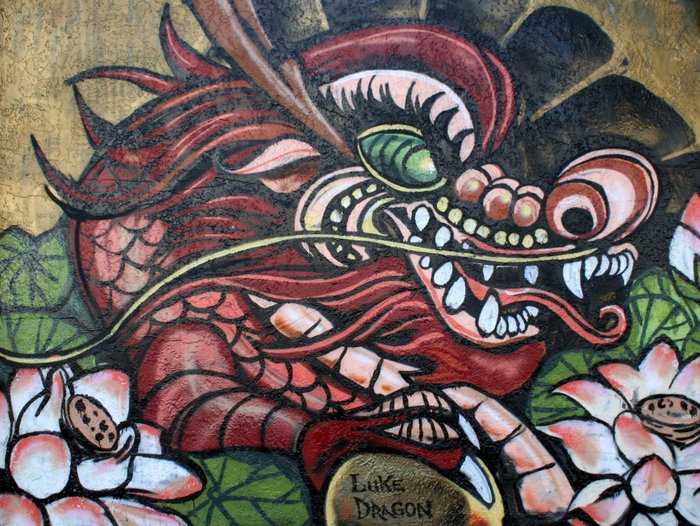
10th and Webster. “There are a few nice pieces here. As a whole, they work very well together. There are a set of dragons that have evolved, originally gold and black and now repainted in color.” – Anderson Gin
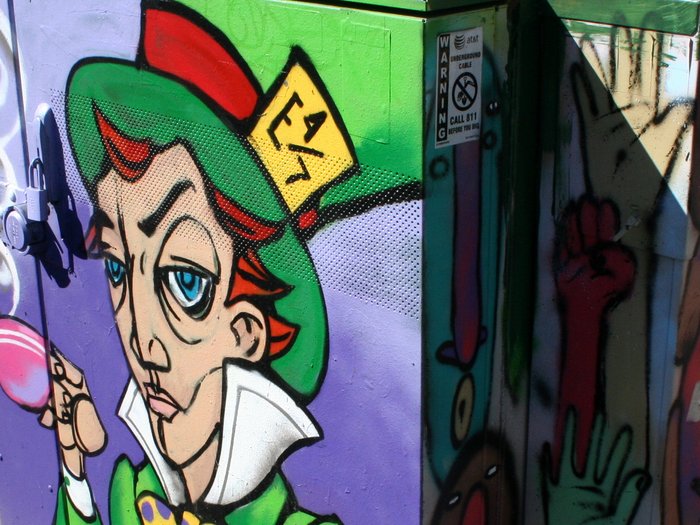
10th and Alice. “We matched the corner bakery’s Alice in Wonderland theme on the electrical boxes and light poles nearby.” – Michelle Chan
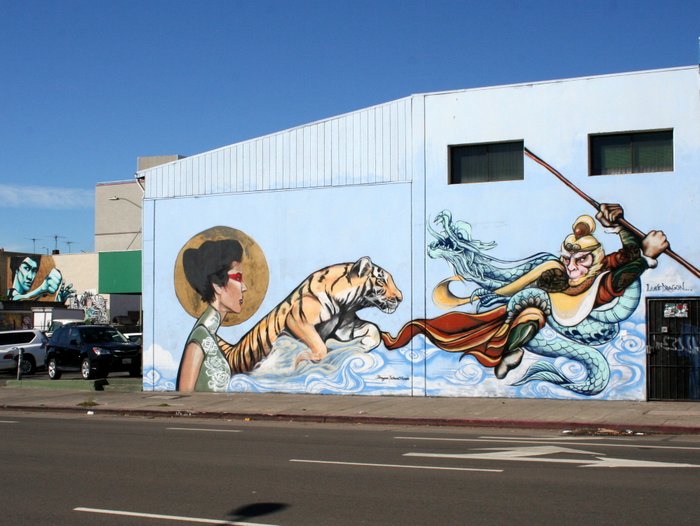
7th and Harrison. “This is an area with a lot of work created by the students and Dr. Dragon, who started the project. You see a monkey king, a tiger and Bruce Lee, when you look up. It’s a nice combination of work.” – Anderson Gin
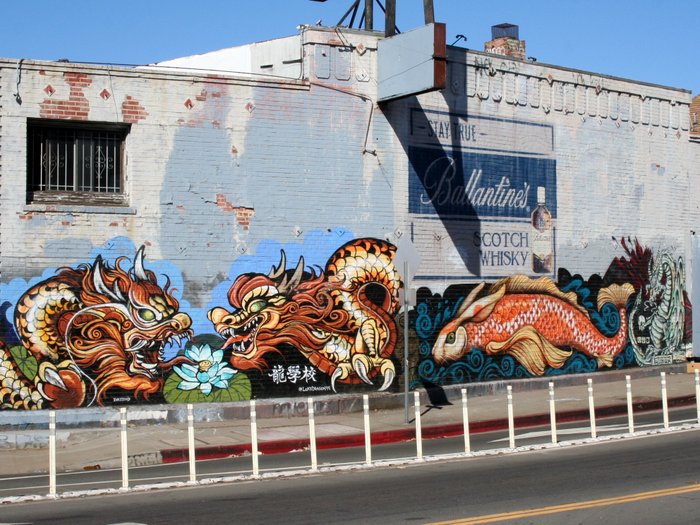
6th and Jackson. “We painted the entire building with dragons. It’s a good looking piece off the beaten path. The koi bunny and black and gold dragons were some of the first pieces I saw coming off the highway into Oakland.” – Michelle Chan
###
Your turn! What do you think of Dragon School’s artwork in Oakland Chinatown? What inspiration do you draw from their murals?
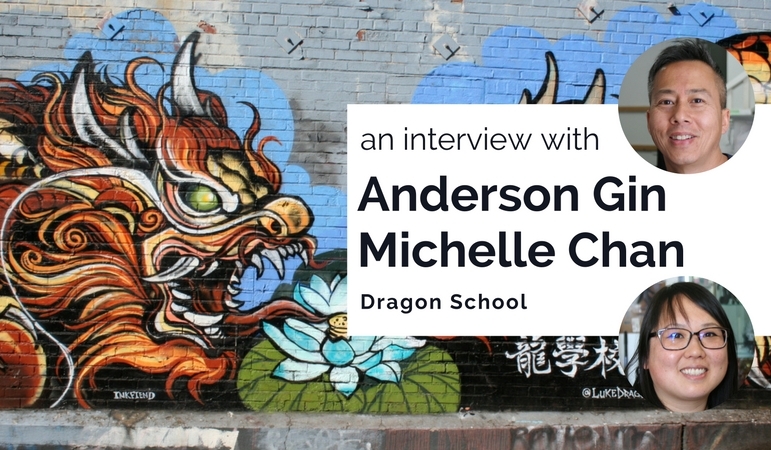




Leave a Reply